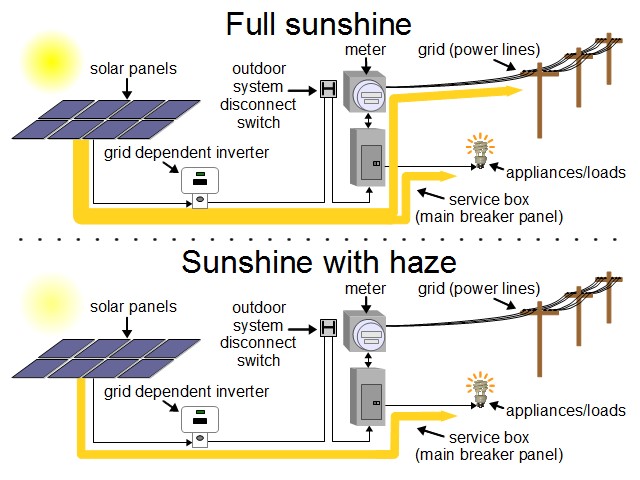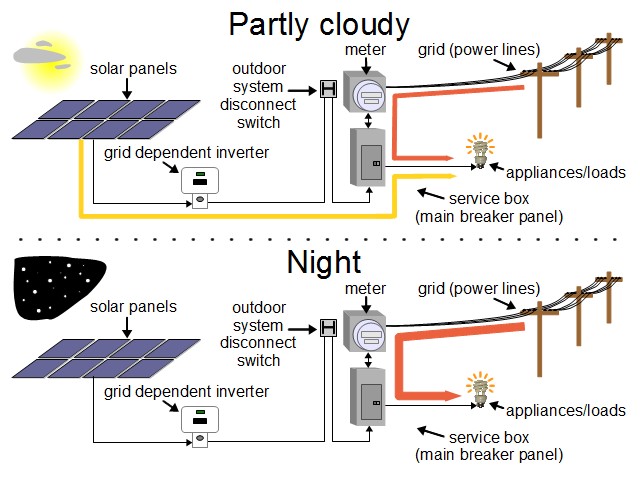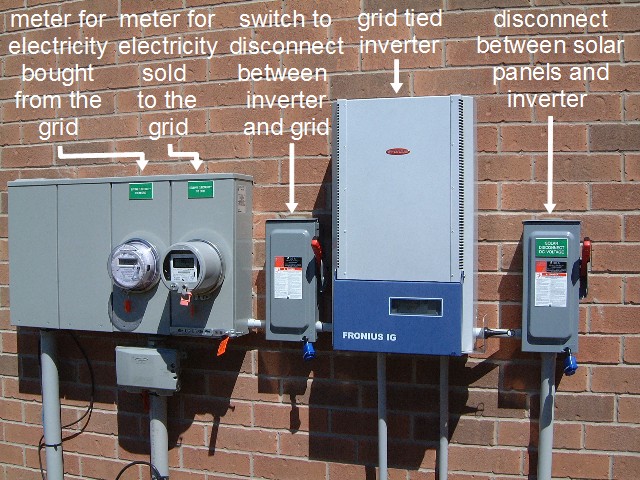Net metering
What is net metering
Net metering involves generating electricity with solar panels, using however much electricity you need and then feeding the remainder onto the grid. If you don't generate enough for your own needs, which you certainly won't at night, then you take electricity from the grid.
The diagrams below illustrate the various possiblities. Pay attention to the sun conditions, and when electricity flows through the meter to and from the grid.


- Full sunshine - Your solar panels generate enough electricity to meet your needs and the leftover goes through the meter to the grid. This assumes you have enough solar panels to meet your needs under ideal sunlight.
- Sunshine with haze - Under slightly dimmed sunlight due to haze, you might generate enough electricity to meet your needs but not have any excess to put on the grid. In that case, nothing flows through the meter.
- Partly cloudy - If it's partly cloudy then you may not generate enough for your needs and have to take some from the grid. Notice that in this case some electricity flows through the meter from the grid.
- Night - At night, you won't be generating any electricity. In that case all your needs will be met by the grid. Notice again that the electricity flows through the meter from the grid.
You don't get paid for what you put on the grid. Here's how it works, using the net metering program in Ontario, Canada as an example. More details about Ontario's program are here. Other locations may vary:
- Any electricity you take from the grid is added to your bill.
- Any electricity you put on the grid is subtracted from your bill.
- If the net amount shows that you took more than you put, then you'll be billed for that net amount.
- If the net amount shows that you put more than you took, then that'll be remembered as a credit toward the next billing period.
- If you have 12 billing periods in a row where you paid nothing, but instead added more credit to the total each time, then after the 12th billing period the total credit is erased and you start over.
All of the above is measured based on what goes through the meter, as shown in the diagrams. In some locations the meter is a bi-directional meter so that it works in both directions (e.g. Ontario, Canada). In other places there may be two meters.
Notice that you pay for the net of what goes through the meter when you put on the grid and when you take from the grid. That's why it's called "net metering". However, depending on your location, the net may instead be calculated based on the monetary values for what you put on the grid and what you take from the grid. That's because some programs will pay a different amount for what you put on the grid and what you take from the grid. Ontario, Canada's program is calculated that way, though usually the dollar per kilowatt works out to the same for each direction anyway.
Even though you may have a credit, you'll still be billed for things on your bill that are not based on how much electricity flowed. Some of these things vary depending on which local distribution company you use (e.g. Hydro One, Toronto Hydro). Some possible things are:
- meter rental,
- administration, account fee or service charge,
- grid maintenance fee,
- and so on.
Basically, look on your bills for things that are not a mulitple of the electricity you used, keeping in mind that some items may be a mix of the two and it may be hard to separate them out.
More net metering system components details
In the photo below you'll see an example of a system with two meters, one for each direction.
You'll also note that in the diagrams above and in the photo below, there's a disconnect switch beside the meters. If you are feeding power to the grid then you are an electricity generator for the grid. If there is a power failure on the grid due to something happening in your area, say a lightning strike damages something, then the grid workers will come out to fix the problem. Normally you'd think that since the grid is down the workers would be safe to do what they need to do. However, that's not true since your system is putting electricity on the grid.
For that reason, a system that feeds electricity to the grid must have a disconnect switch that is outside (see photo below) so that the grid workers can disconnect your system from the grid. Another typical rule is that they must be able to lock the disconnect switch. That's so that no one else can come along and reconnect your system to the grid while they're still working.

Note that normally a grid tied inverter would automatically realize that the grid has gone down and stop putting electricty on the grid. But there's always the possibilty of something being wrong with the inverter and it continuing to put electricity on the grid.
Calaculating the payback period for a net metering system
The following is a rough back-of-the-envelope calculation for the payback period for a net metering system. All assumptions and calculations are shown so that you can do this for your own area too.
The cost of solar panels still plays a big part in the decision as to whether or not to go with this approach. The following starts out with a 10kW roof mounted system but changes as we do the calculation.
| Cost | Item |
|---|---|
| $12,000 | 40 solar panels x 250W per panel at $300 each |
| $500 | racking/frame |
| $3,950 | 10kw grid-tie inverter |
| $700 | wiring on and from the solar array |
| $200 | other parts/hardware |
| $300 | shipping fees |
| $2,050 | various fees (inspection fee, connection cost, building permit, meter) |
| $3,000 | certified electrican for final connection |
| $5,000 | installation/labour |
| $27,700 | Subtotal |
| $3,600 | taxes (HST: 13%) |
| $31,300 | Total |
Now that we have the system cost, we can do some calculations. Here's what we start with:
- System cost: $31,300
- System size: 10kW (kW = kilowatts)
- Monthly kWh used: 800kWh (kWh = kilowatt hours)
- Cost per kWh: $0.077/kWh
- Average sunlight per day: 3.4h (h = hours)
Note: The 800kWh used is less than the monthly average for a household in the US, which is $1000 (Canada's is similar). Using 800kWh allows us to explain more below. The $0.077/kWh is based on tiered pricing for residential in Ontario, Canada and is subject to change. The 3.4 hours of sunlight is for Toronto, Ontario, Canada.
Each month you produce 3.4h x 10kW x $0.077/Kwh x 31 days = $81.16
Each month you consume 800kWh x $0.077/kWh = $61.60
Since you're producing $81 worth of electricity but using $61, that means that each month you have a credit of $20 that goes to the next month. But that all vanishes if you have an excess for 12 months in a row. So your savings is really just the amount of electricity you didn't have to pay for, the $61 per month, or $732 per year ($61/month x 12 months).
Given a system cost of $31,300, that would take 42.8 years to pay back ($31,300 / $732)!
But keep in mind, you bought a bigger system than you needed since you were producing $81 worth of electricity but using only $61. So how big would a system have to be to produce only $61 per month?
Going back to the calculation for how much you produced each month,
3.4h x 10kW x $0.077/Kwh x 31 days = $81.16
we first replace some values. We want to generate only as much as we use, $61, and we want to know how much power we'd need to produce that $61 worth of electricity.
3.4h x ?kW x $0.077/Kwh x 31 days = $61
and rearrange it to solve for the ?kW.
?kW = $61 / (3.4h x $0.077/Kwh x 31 days) = 7.5kW
Next, we redo our table with only enough solar panels to produce 7.5kW and a smaller inverter to match.
| Cost | Item |
|---|---|
| $9,000 | 30 solar panels x 250W per panel at $300 each |
| $500 | racking/frame |
| $2,800 | 7.5kw grid-tie inverter |
| $700 | wiring on and from the solar array |
| $200 | other parts/hardware |
| $300 | shipping fees |
| $2,050 | various fees (inspection fee, connection cost, building permit, meter) |
| $3,000 | certified electrican for final connection |
| $5,000 | installation/labour |
| $23,550 | Subtotal |
| $3,060 | taxes (HST: 13%) |
| $26,610 | Total |
So with the fewer solar panels and smaller inverter...
Each month you produce 3.4h x 7.5kW x $0.077/Kwh x 31 days = $60.89Each month you consume 800kWh x $0.077/kWh = $61.60
That $61 per month is again $732 per year. Given our new system cost of $26,610, that would take 36.4 years to pay back ($26,610 / $732)!
This doesn't include the other fixed costs, but given the long payback time, that doesn't matter much.
This is also based on an annual average of 3.4 hours of sunlight per day, which is about right for Toronto, Ontario, Canada. If you're in Arizona then the average is around 6.5 hours so you'd generate more electricity for the same system and so be able to buy a smaller one, shortening your payback time.
